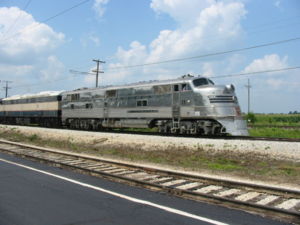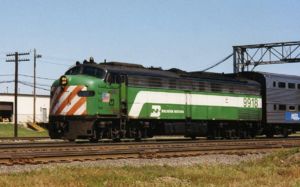EMD E-unit
EMD E-units were a line of passenger train diesel locomotives built by the General Motors Electro-Motive Division (EMD) and its predecessor the Electro-Motive Corporation (EMC). Final assembly for all E-units was in La Grange, Illinois. Production ran from May, 1937, to December, 1963. The name E-units refers to the model numbers given to each successive type, which all began with E. The E originally stood for eighteen hundred horsepower (1300 kW), the power output of the earliest model, but the letter was kept for later models of far higher power ratings.
The predecessors of the E-units were the EMD 1800 hp B-B locomotives built in 1935. These had similar power and mechanical layouts to the E-units, but enclosed in boxcab bodies and with AAR type B two-axle trucks.
EMD also introduced the TA model in 1937, selling six to the Rock Island. This had very similar carbody styling, but otherwise had more in common with UP M-10001, M-10002, and M-10003 through M-10007, in that it was a 1,200 hp (900 kW), single-engined unit on B-B trucks instead of the E-units' A1A-A1A wheel arrangement. It is therefore not part of the E-unit series.
Like many early passenger locomotives, E-units used two engines to achieve the rated power. This was due to the technology of the time limiting the power that could be developed by a single engine. Even so, while E-units were used singly for shorter trains, longer trains needed multiple locomotive units; many railroads used triple units. E-units could be purchased either with or without driving cabs; units with a cab are called A units or lead units, while cabless units are called B units or booster units. B units did contain simple controls for moving them in railroad yards, but they could not be so controlled on the main line. The locomotive units were linked together with MU cables which enabled the crew in the lead unit at the front to control the trailing units. Railroads tended to buy either ABA sets (two driving cab-equipped units facing in opposite directions with a booster in between) or ABB sets (a single driving cab with a pair of boosters). The former did not need to be turned to pull in either direction, but B units were cheaper than A units and they made for a smoother line to the train.
Contents
Styling
The EA and E1 had sloping noses with recessed headlights, while the E2 had a more aggressively bulbous "bulldog" snout. Models E3 through E6 had a sloping nose but with a protruding headlight, while models E7 through E9 used a shorter-snouted, more vertical style very similar to that used on the freight F-units.
Other changes were more fluid, and many older E-units were updated to newer styles. The E8 introduced the one-piece stamped Farr stainless-steel side grilles that made a continuous band from front to rear just below the roof, but these were often retrofitted to earlier units. Side windows were half-rounded on the EA/EB, square on the E1, round on the E2, square on most E3 through E7 units, and rounded portholes again on the E8 and E9, but again many railroads updated older locomotives.
The E5 units were unique, produced for the Chicago, Burlington and Quincy Railroad in all stainless steel with fluted lower carbody sides, to match the railroad's Zephyr passenger trains.
Engines
While there were some cosmetic differences between E-unit models, the major line of development was technological, and largely that of increasing power. For example, the first model in the series, the EA/EB, was rated at 1800 hp (1300 kW). An intermediate unit, the E3, was rated at 2,000 hp. The last unit in the series, the E9, was rated at 2,400 hp (1800 kW). This enabled heavier trains to be pulled by the same number of locomotives, or the same weight of train could be pulled faster.
Early models (EA/EB through E2) used the Winton 201-A engine that had been purchased by Electro-Motive Corporation, the immediate ancestor of the Electro-Motive Division of General Motors. This engine was originally designed for submarine use, and wasn't well suited to the sustained full throttle operation often demanded in railroad service (especially in mountain operation). It was not unusual for heavy repairs to be done en route on one non-functioning engine while the other engine propelled the train at reduced speed. The 201-A engines used in E-units were 900 hp (700 kW) V12 units.
Models E3 through E9 used the EMD model 567 engine, named after its engine displacement in cubic inches per cylinder. Although similar in some ways to the earlier Winton design, the 567 model had been developed by EMD specifically for locomotive use, and exhibited excellent performance and reliability in high speed passenger train service. The 567 had a greater displacement per cylinder than the 201-A and ran at a higher maximum rpm, elements which when combined gave greater engine output. The 12V-567 V12 model used in the E3 through E7 developed 1000 hp (750 kW). The E8 used the more advanced 567B unit, with improved exhaust manifolds and other enhancements to give 1,125 hp each. More development resulted in the 1200 hp (900 kW) 567C engine used in the E9.
Other changes
Other improvements occurred independently of the change in engine design. The E8, for example, was the first model to incorporate electric cooling fans, and offer dynamic braking as an option.
Trucks
All E-units used the same EMD passenger truck design by engineer Martin Blomberg. This was an A1A-A1A truck, with the outside axles powered and the inner axle unpowered. Like the well-known two-axle "Blomberg B" trucks, these trucks featured outside spring hangers between the wheels for better cushioning of side-to-side motion. Also like the Blomberg B, there were no drop equalizers between the axles. The success of the design is demonstrated by the remarkably few changes to it over the years.
Complete list of models
- EA/EB - for B&O; 6 A units and 6 B units constructed.
- E1 - for ATSF; 8 A units and 3 B units.
- E2 - for jointly owned and run UP, C&NW, and SP trains City of San Francisco, City of Los Angeles. 2 A units, 4 B units.
- E3 - Total of 16 A units plus 2 B units built, for ATSF (1 A, 1 B), ACL (1 A), RI (2 A), FEC (2 A), KCS (2 A, + ex EMD demonstrator A), C&NW (4 A), MP (2 A), and UP (1 A, 1 B).
- E4 - for SAL; 14 A units, 5 B units constructed.
- E5 - for the Burlington; 11 A units and 5 B units constructed.
- E6 - 92 A units and 26 B units built.
- E7 - 428 A units and 82 B units built.
- E8 - 421 A units and 39 B units built.
- E9 - 100 A units and 44 B units built.
Oddities
- AB6 - B units built with a flat-fronted driving cab for the Chicago, Rock Island and Pacific Railroad. These were used to take one portion of a train onward to a side destination while the rest of the train continued onward.
- Missouri Pacific 7100 - half an E6, with a single 1,000 hp (750 kW) engine and a baggage compartment where the rear engine would have been..
- CNW E9BS Crandall cab - E9 B units converted to A units with a squarish cab built in the railroad's own shop.
Surviving E-units
A number of E-units survive, and there are a good number in running order. Several railroads retain a set of E-units to haul passenger specials, management inspection specials, and the like. Others survive in museums or on short lines.
References
- Marre, Louis A. (1995). Diesel Locomotives: The First 50 Years, pp.114-126. Kalmbach Publishing Co. ISBN 0-89024-258-5.
- Pinkepank, Jerry A. (1973). The Second Diesel Spotter's Guide. Kalmbach Publishing Co., Milwaukee, WI. ISBN 0-89024-026-4.
- Solomon, Brian (2000). The American Diesel Locomotive, pp.53-56, 63, 65, 67, 68, 70. MCI Publishing Company. ISBN 0-7603-0666-4.
Diesel cab and cowl locomotives built by EMD | |
|---|---|
| Cab units (F- & E-units) | FT · F2 · F3 · F7 · FP7 · F9 · FP9 · FL9 · TA · EA/EB · E1 · E2 · E3 · E4 · E5 · E6 · E7 · E8 · E9 · AA · AB6 |
| Cowl units | F45 · FP45 · F40C · F40PH · F40PH-2 · F40PH-2C · F40PH-2M · SDP40F · SD40-2F · SD50F · F59PH and F59PHI · SD60F · F69PHAC · DE30AC · DM30AC |
| See also: List of EMD locomotives | |


